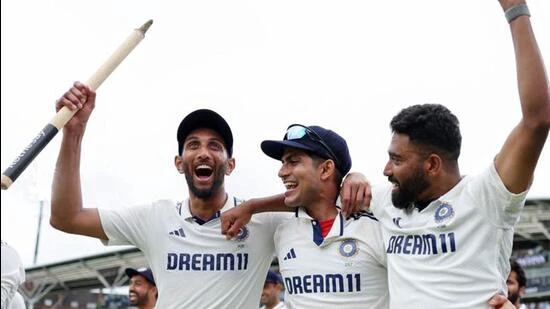In January, an India team with a multi-star cast lost the tour of Australia 1-3 with the captain Rohit Sharma missing the first Test and sitting out of the last.
Ravichandran Ashwin shocked the world by retiring midway into the series. Jasprit Bumrah broke down in the final game and Virat Kohli went off the boil after starting with a hundred in Perth.
Seven months on, India have squared a series in England in the absence of Kohli, Sharma and Ashwin, winning two Tests not featuring Jasprit Bumrah, one of them also without Rishabh Pant, and amid much criticism over their cautious selection strategy that refused Kuldeep Yadav a place in all five Tests.
This has also been a sensational coming of age for Shubman Gill, breaking Sunil Gavaskar’s record of most runs by an Indian captain on a single tour. In Washington Sundar, India have found an allrounder willing to graft valuable partnerships when not drawing batters out of their crease with loopy off-breaks. Once again, Ravindra Jadeja proved his worth with five fifties and a resilient hundred that allowed India to draw the Manchester Test and take the series to a decider at the Oval.
At the top, quietly but surely India have forged an all-weather opening combination with Yashasvi Jaiswal as the aggressor and KL Rahul as the anchor. Between them India got four hundreds, four fifties and 1664 balls faced across five Tests. On the bowling front, India can finally breathe easy now that Siraj has established himself as the go-to man for breaking partnerships or just putting in long spells.
Biggest takeaway? The belief that no adversity can be daunting enough for this team. If India’s batting rearguard at Old Trafford was admirable, their fightback at the Oval with just 35 runs in the bank was simply breathtaking. “This morning kind of summarized what this team is all about,” Gill said after the match on Monday. “70 odd runs, 7 wickets in hand. The way Brook and Root were going, not many teams in the world would have given themselves a chance. But this team believes that whenever we have some kind of an opening, we can make that, we can get through that opening.”
That said, India still have a few problems to sort out. There is a visible indecision over the No 3 spot, with both Karun Nair and Sai Sudharsan putting in some good work. Nair’s technique came to India’s rescue in the form of a gritty fifty at the Oval but if India are to build this team for the future, they have to think more long-term with Sai Sudarshan who is a decade younger than Nair.
The elephant in the room however is the strategy behind picking India’s bowling attack. Be it in Australia or in England, India have leaned towards making the line-up batting heavy. It didn’t work in Australia. England witnessed mixed results. Nitish Kumar Reddy and Shardul Thakur haven’t really aced the medium-pace allrounder job, meaning India’s fast bowlers were often stretched in England on flat pitches that offered no assistance at all.
It was a miracle that Siraj got through all five Tests unscathed but worrying was how the comparatively untested and better rested Akash Deep was prone to breakdowns. Trying Anshul Kamboj at Manchester was a punt gone horribly wrong but more deflating was the pace with which he was bowling as the third change fast bowler. The bigger reason why Jadeja and Washington were picked together was the solidity they added to the batting line-up. And while India may have passed this test by the barest of margins, they might want a relook at the strategy behind benching their best spinner on some tracks that could have easily been passed off as Indian.
